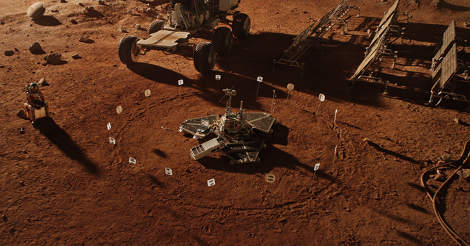
Last week I started a series responding to reader questions about evolution. I explored the idea that God expresses his creativity by defining relationships while leaving matters of form at least partially open for creation to work out. If God does create that way, then an evolutionary process seems plausible as a method for creation. However, I can see where my description of God specifying requirements might seem at odds with my claim that God is continually creating and instead raise questions about deism. Indeed, such questions seem to arise whenever an evolutionary process is proposed for creation. If life is evolving “on its own” then whatever role God might have had, wasn’t it in the distant past? What is there left for God to do now?
From my perspective, any understanding of God’s activity that focuses primarily on creation has the potential to seem like deism. If God created all of life’s diversity directly over the course of a week 6,000 years ago, the job was done then. If God created all the rules of nature at the moment of the Big Bang and then let everything work itself out, his job was done nearly 14 million years ago. As Christians, we respond to deism in part by noting that God is active as more than a creator, he engages with creation through the incarnation and the Holy Spirit. Still, if evolution is an ongoing process, and if that is the way in which God creates, then at least there is the possibility that God’s creative acts continue in the present.
So then what do these ongoing creative activities look like? Are we back to God ordaining each and every mutation? I have another picture in mind. From the theological side, it is motivated by two ideas. One is that God is consistent. The other is that God is a spiritual being rather than a physical being. How exactly a spiritual being works is a tricky thing to imagine. But it’s an important idea to keep in mind, because the most intuitive pictures of God creating are extrapolated from our own experiences. It is natural to picture hands shaping clay or assembling parts, but we must remind ourselves that on some level these analogies break down because God does not have physical hands. Perhaps already you can see where a spiritual God would deal with relationships over forms since he himself does not have a form, and where a consistent God would be continually engaged in creation.

 )
)Those theological notions are still rather abstract, which is why I also find it helpful to bring a scientific dimension to my picture of how God creates. For that we need to talk about information. We’ve encountered information theory before. Information theory quantifies communication, allowing engineers to figure out how many telephone calls can go across a wire or how many streams of House of Cards can be handled by a single server. Messages are measured in bits. A single bit is basically the answer to a single either/or question–to be or not to be, should I stay or should I go, is you is or is you ain’t my baby. If you have two mutually exclusive choices, it takes a single bit to communicate which choice you made. More options mean more bits. Something like a Netflix stream needs to communicate which of a few million colors should be displayed at each of 2 million pixel locations; that can require up to 50 million bits, 24 times per second. (That’s an upper bound; in practice you can use far fewer because the colors are related rather than completely random.) These bits are the fundamental piece of information.
Information get tricky when you factor in meaning. Bits don’t measure meaning; the size is the same whether the answer is ‘stay’ or ‘go,’ whether the color is ‘red’ or ‘blue.’ In a sense, then, the meaning isn’t in the message. For communication to work, the sender and the recipient have to agree on meanings separately. For example, Paul Revere and his collaborators had to agree that one light would mean ‘land’ and two lights would mean ‘sea;’ there’s nothing inherently land-ish about one lamp. You can experience this for yourself while streaming Netflix. You can change the meaning of the message by fiddling with the settings on your TV, making the picture brighter or darker, more red or more green or more blue, and so on. Changing House of Cards into Fuller House would be quite a bit trickier and require fiddling with knobs that your TV set likely doesn’t provide, but theoretically it could be done.
The fact that you can change the picture on your end doesn’t mean that the sender didn’t intend any particular result. When directors film stories, they have a very specific set of images they wish to convey. To see those particular images, you and the sender have to agree on a meaning, usually by using calibration tools that basically say “These bits will always mean this color yellow, while those bits will always mean that shade of black.” Calibrating your television thusly is the only way to be sure you are seeing what the sender intended.
Information also conveniently isn’t restricted to a particular form. You can represent bits in a beam of a light, an electrical current, a sequence of coins heads-up or heads-down, a set of switches, or any number of other ways. For communication in the physical world, it does need some physical representation, but in a way there is an immaterial reality to the message independent of its medium.
While I wouldn’t go so far as to say God is information, I do think information is a helpful analogy for thinking about God’s spiritual nature. While God can be incarnated in physical form, he has a reality beyond that form. The analogy also helps think about how God creates. God communicates his intentions for creation, but creation can interpret the messages in different ways. In terms of DNA, that may result in mutations other than what God would intend. And while the message may be consistent across time, the specific context of creation at a given moment will determine which interpretations are possible and which elements of the intended result can be realized. God’s activity remains the same, creation remains ongoing, but the end result that we experience changes over time as it incorporates both God’s intention and creation’s interpretation.
Next week we’ll take another look at sources of variation, including possible contributions from viruses.
Andy has worn many hats in his life. He knows this is a dreadfully clichéd notion, but since it is also literally true he uses it anyway. Among his current metaphorical hats: husband of one wife, father of two teenagers, reader of science fiction and science fact, enthusiast of contemporary symphonic music, and chief science officer. Previous metaphorical hats include: comp bio postdoc, molecular biology grad student, InterVarsity chapter president (that one came with a literal hat), music store clerk, house painter, and mosquito trapper. Among his more unique literal hats: British bobby, captain’s hats (of varying levels of authenticity) of several specific vessels, a deerstalker from 221B Baker St, and a railroad engineer’s cap. His monthly Science in Review is drawn from his weekly Science Corner posts — Wednesdays, 8am (Eastern) on the Emerging Scholars Network Blog. His book Faith across the Multiverse is available from Hendrickson.

Brian:
I wonder how your concept of God squares or doesn’t square with the view expressed by David Bentley Hart in The Experience of God: Being, Consciousness, Bliss.
Jim Sire
Jim,
Good question. I’ll need to read that book to give a complete answer. From the summaries I read, I can see where there are likely points of commonality, such as an emphasis on God’s transcendence and on the limitations of thinking of God as a more powerful version of a human. It also sounds like that particular book focuses on the features of God common across monotheistic traditions, where I am primarily interested in the Christian tradition. If that wasn’t readily apparent in this particular post, it’s because I was trying to focus on a particular aspect of divine action rather than a complete description of God.
Were there particular points from Hart’s description of God that struck you as similar to my ideas?